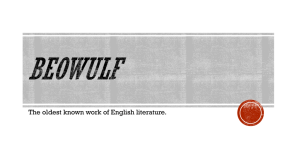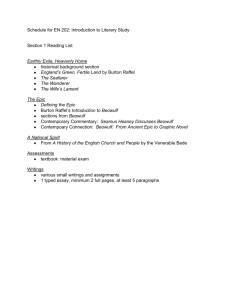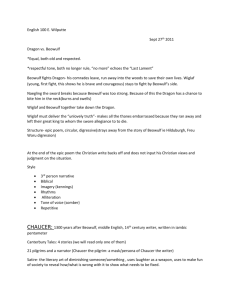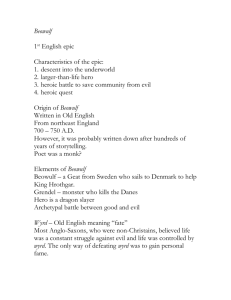Click here
advertisement
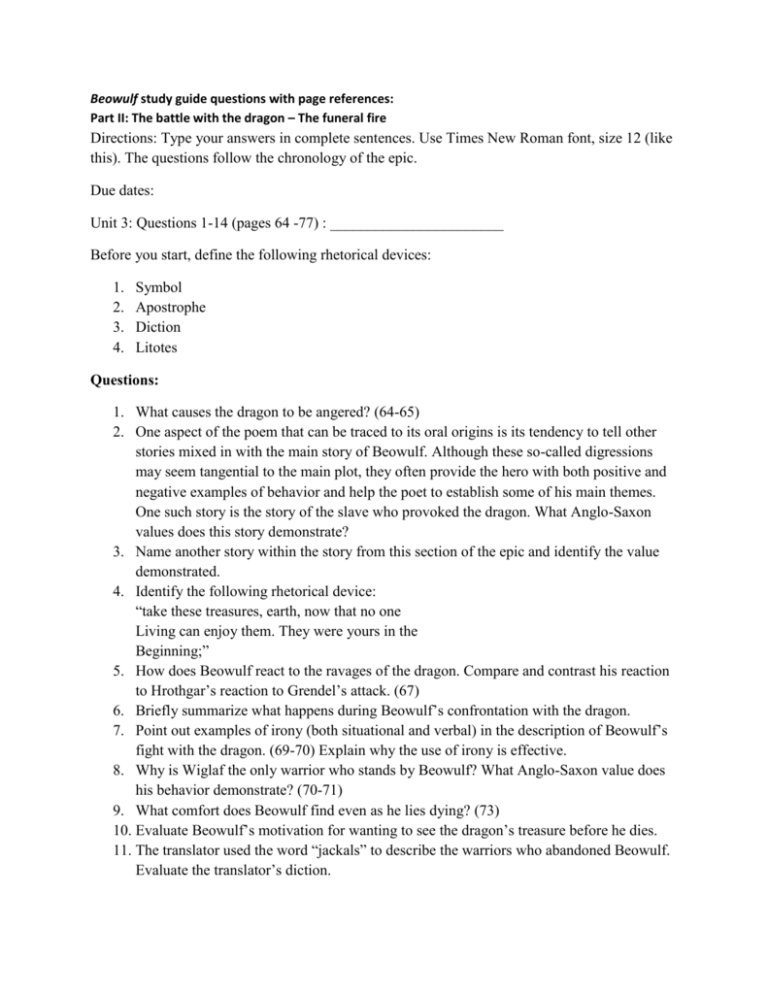
Beowulf study guide questions with page references: Part II: The battle with the dragon – The funeral fire Directions: Type your answers in complete sentences. Use Times New Roman font, size 12 (like this). The questions follow the chronology of the epic. Due dates: Unit 3: Questions 1-14 (pages 64 -77) : _______________________ Before you start, define the following rhetorical devices: 1. 2. 3. 4. Symbol Apostrophe Diction Litotes Questions: 1. What causes the dragon to be angered? (64-65) 2. One aspect of the poem that can be traced to its oral origins is its tendency to tell other stories mixed in with the main story of Beowulf. Although these so-called digressions may seem tangential to the main plot, they often provide the hero with both positive and negative examples of behavior and help the poet to establish some of his main themes. One such story is the story of the slave who provoked the dragon. What Anglo-Saxon values does this story demonstrate? 3. Name another story within the story from this section of the epic and identify the value demonstrated. 4. Identify the following rhetorical device: “take these treasures, earth, now that no one Living can enjoy them. They were yours in the Beginning;” 5. How does Beowulf react to the ravages of the dragon. Compare and contrast his reaction to Hrothgar’s reaction to Grendel’s attack. (67) 6. Briefly summarize what happens during Beowulf’s confrontation with the dragon. 7. Point out examples of irony (both situational and verbal) in the description of Beowulf’s fight with the dragon. (69-70) Explain why the use of irony is effective. 8. Why is Wiglaf the only warrior who stands by Beowulf? What Anglo-Saxon value does his behavior demonstrate? (70-71) 9. What comfort does Beowulf find even as he lies dying? (73) 10. Evaluate Beowulf’s motivation for wanting to see the dragon’s treasure before he dies. 11. The translator used the word “jackals” to describe the warriors who abandoned Beowulf. Evaluate the translator’s diction. 12. What does Wiglaf say to the cowardly soldiers after Beowulf’s death? Explain how this illustrates the social schema of “comitatus.” 13. What is done with Beowulf’s body? 14. Read the following examples from an alternate translation of the epic. Identify the rhetorical device and explain why it is effective: Near the end of the poem, when the hero has led his warriors to the shore where he suspected the fire-dragon resided and protected her riches, the poet states: “no easy bargain for any man to try to acquire them” As the hero went to face the fire-dragon, he “trusted the strength of a single man – hardly the coward’s way.” As Beowulf enters into combat with the dragon: “the good war-king had already drawn his heirloom sword, an edge not dull.” When Wiglaf talks of the hero: “I know for a truth that the worth of his deeds is not so poor”

